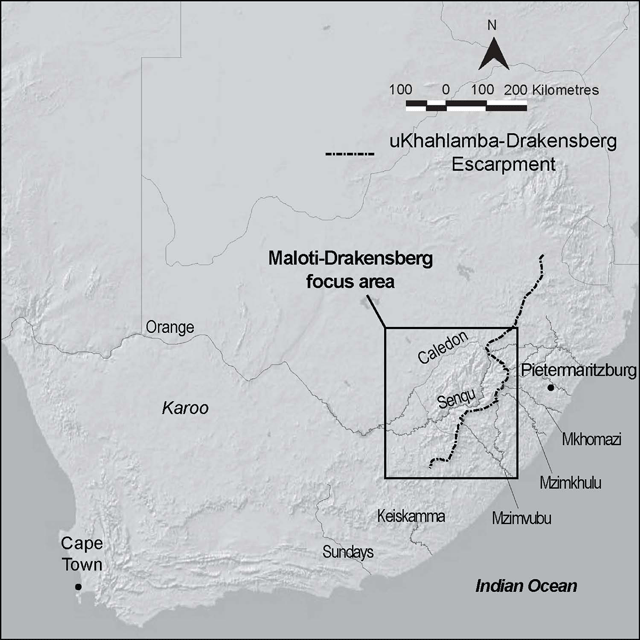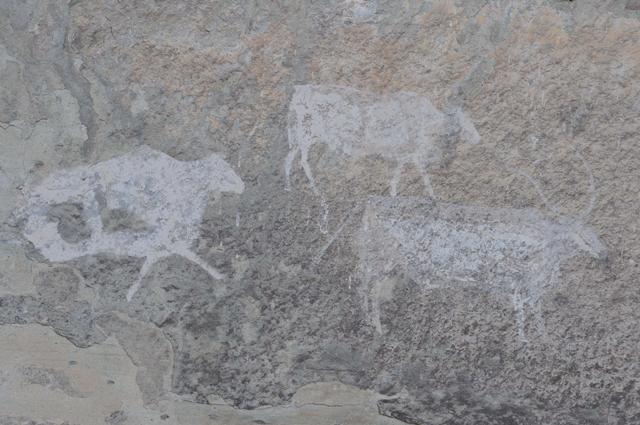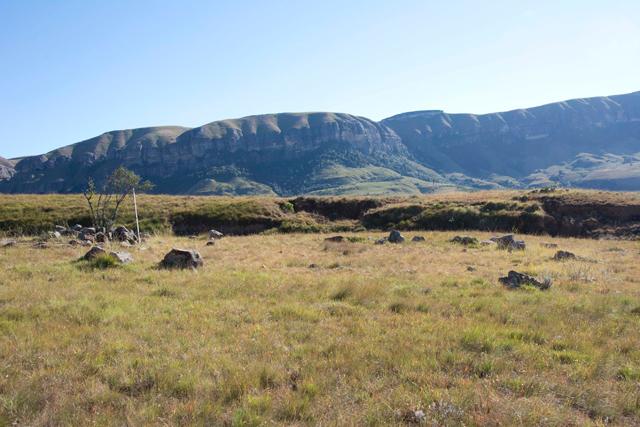Despite their environmental and geo-political marginality, southern Africa’s Maloti-Drakensberg Mountains (Figure 1) have been a significant locus of cultural creativity over the last two millennia. The past few decades have witnessed a steadily growing number of excavations on either side of the uKhahlamba-Drakensberg Escarpment, enabling a view of trans-montane connections between hunter-gathering and farming communities beginning around 1800 BP (Mitchell 2009a, 2009b). Particularly in the highlands of modern-day Lesotho, finds of domestic fauna and worked metal in late first-millennium hunter-gatherer encampments attest to the incorporation of new technologies and social connections into lifeways that also emphasised foraging and fishing. Looking to the late second millennium AD, these mountains continued as a hub of interaction, with rock art offering insight into how cohorts of cattle-and-horse raiders forged new identities (Blundell 2004; Challis 2012, 2014, 2016; Mallen 2008). With crop agriculture and apparatuses of the colonial state restricted to the lowlands until the 1880s, the upper reaches of the Maloti-Drakensberg in the nineteenth century became an ‘interior world’ (King and Challis 2017) where mobile polities and those cast as ‘criminals’ by the state could retain a measure of autonomy.

Map of southern Africa showing Maloti-Drakensberg study area. Map created using ArcGIS® software by Esri. ArcGIS® and ArcMap™ are the intellectual property of Esri and are used herein under license. Copyright © Esri. All rights reserved.
In this long view of the last two millennia in the Maloti-Drakensberg, archaeological evidence tends to cluster at two points in the chronological sequence: the mid-to-late first millennium AD when hunter-gatherer contact with agriculturists effloresces, and the nineteenth century when the mountains became a notorious ‘nest of thieves and vagrants’ (Theal 2002: V, 208). Our project ‘Changing Hunter-Gatherer Lifeways’ targets the missing middle period in the second millennium. The project seeks to establish a chronologically constrained understanding of how mobile montane lifeways changed amidst a series of relatively rapid transformations occurring within and around the Maloti-Drakensberg. These transformations include an increasing agriculturist presence in the lowlands and livestock grazing in the highlands, changing patterns of wild game movement (especially elephants), and the onset of the Little Ice Age (c. 1500–1800 AD). To achieve the chronological resolution and material detail needed to address these questions, we have considered a diverse range of archaeological evidence and site types: open air settlements (including stone-walled villages) and rock shelter encampments at multiple altitudes, rock art, and lithic and ceramic assemblages from new excavations and established collections. We aim to extend an earlier major programme of research that developed new techniques for directly dating and chemically characterising rock art pigments (Bonneau et al. 2011, 2014, 2017a, 2017b; Bonneau, Pearce and Higham 2016; Bonneau, Pearce and Pollard 2012; Hœrlé et al. 2016), specifically targeting images that can be linked to the second millennium AD (Figure 2).

Paintings of cattle at the nearby FRE4 painted site. Five human figures painted in this shelter have been directly dated to 1297–present cal. BP (Bonneau et al. 2017a). Reproduced with permission.
Our project therefore builds on a growing body of research attesting to the significance of the Maloti-Drakensberg for understanding the dynamics of montane subsistence lifeways in sub-Saharan Africa, as well as continuing to develop cutting-edge analytical techniques. Further, we are endeavouring to build a picture of long-term history in the Maloti-Drakensberg that emphasises the creativity and contingency of how materials were created and used, and that takes a holistic view of the networks of knowledge and exchange at work by focusing on archaeology traditionally attributed to hunter-gatherers and agriculturists within the same research framework. Taking this approach enables us to address the nineteenth and twentieth century narratives that depict the Maloti-Drakensberg as an untamed and untameable wilderness, and permit discussion of the rich cultural logics that prevailed in a place long treated as peripheral to the transformations that shaped southern Africa (King 2017).
Mixed Methods, Mixed Spaces
An enduring problem confronting southern African archaeology is tying the occupation of rock shelters to open-air sites and/or stone-walled settlements during the last millennium. This is due largely to preservation issues, few adequate provenance studies of lithic and ceramic raw materials, and a lack of sufficient chronological resolution tying the two spaces together. Our project aims to achieve this through radiometric dating and chemical characterisation of rock art pigments taken from rock shelters and excavation of stone-walled sites dating to within the last 500 years. This strategy represents a joining of two long-standing research projects in the Maloti-Drakensberg: one focusing on rock art pigment analysis, the other on characterising strategies for settlement and mobility in open-air sites. Beginning in 2016, this work has focused on a section of Maclear District, representing the south-western edge of the Maloti-Drakensberg. Previous rock art pigment studies analysed 23 samples from six sites, giving a chronological range of 2998 cal. BP to the present (Bonneau et al. 2017a).
Archaeological survey of a farm within this district identified a cluster of abandoned stone-walled structures and associated middens (a site designated as ‘Woodcliffs’), one of which was selected for excavation on the basis of pottery scattered on its surface (Figure 3).

View over the Woodcliffs site showing its position on a spur overlooking a wide valley. Some stone walling is visible on the surface. Photo: D. Pearce.
Excavations demonstrated that while the upper strata of the midden had been eroded (replaced by colluvial sediments), the lower stratum remained in place and consisted almost entirely of ceramics deposited and fragmented in situ, along with a small number of beads and charcoal. Ceramic fragments were piece plotted and recovered for re-fitting, which is currently in progress but suggests at least three distinct and complete vessels were present, which include decorations and rim motifs. As the Maloti-Drakensberg Mountains have been believed to be relatively inhospitable to ceramic-producing agropastoralists until the nineteenth century, and primarily for those squeezed to the hinterlands by colonial encroachment, the archaeology of these communities has been relatively under-explored (King 2014). As such, our excavations represent one of the largest ceramic assemblages recovered from these mountains, and is certainly the most complete. Optically stimulated luminescence dating of ceramics is currently on-going, but excavated samples of seed beads (recovered using a 0.5 mm mesh) suggest that the ceramic-bearing layer was deposited after 1700 AD.
Painting (and excavating) by Numbers
Underpinning this project is the recognition that developing a picture of hunter-gatherer-agropastoralist interaction in the Maloti-Drakensberg is a matter of assembling data points from a number of small sites rather than one or two large excavations. The archaeology of montane agropastoralists has been particularly elusive, perhaps because the climate and terrain inhibited settlement by people practicing cereal cultivation, but equally because the landscape encouraged an emphasis on livestock transhumance rather than the sorts of extensive crop agriculture available on the lower-lying plains. This project’s finds thus far, combined with earlier excavations, dating programmes, and surveys, are steadily building a view of what economy and belief looked like in the Maloti-Drakensberg, and several themes have become clear which merit further investigation.
First, rock art was likely being executed very close to aggregated dwellings, opening the possibilities of connections between these dwellings and the painters themselves. While rock shelters containing rock art also show evidence of encampment, and painting may certainly have been a practice requiring privacy and specialist knowledge, at Woodcliffs we see it situated close to and possibly integrated within village life. Both painted subjects (cattle and shields, for instance) and dates (Bonneau et al. 2017a) clearly indicate that some paintings are late and relate to contact between groups. In southern Africa, painters’ identities are often considered to be tied to subsistence. For example, fine-line painting traditionally is attributed to San hunter-gatherer style and finger-painted or geometric styles to farmers or herders, respectively. To the extent that we can say anything about the identities of the painters in our region, the location of painting amidst communities of people historically known to be practicing a range of subsistence lifeways – from hunting to herding to cattle rustling – suggests that we need to find other ways of thinking about identification.
Second, historians and archaeologists have long believed that the Maloti-Drakensberg did not support agropastoralist communities until the encroaching colonial frontier and homesteading strategies instituted by the British and Basotho governments encouraged settlers to move into higher altitudes (e.g. Mitchell 2009b, 2010; Vinnicombe 2009 [1976]; Wright 1971). Until then, the mountains were thought to have mainly hosted cohorts of cattle raiders or outlaws, or farming communities who may have temporarily withdrawn to higher ground to escape environmental hardship or political conflict (see King and Challis 2017 for details). Recent work illustrating that these sorts of ‘refugia’ could actually serve as more regular, stable homes (King 2017) has not shifted the conclusion that these mountains were inhospitable to aggregated village life – at least not without encouragement from a strong leader such as the Sotho chief Moshoeshoe I on the north-western side of the Escarpment. Woodcliffs falls outside of Moshoeshoe’s ambit and indeed the ambit of any of the major regional chiefly powers, and forces us to consider that people in the last few centuries chose to settle in the southern mountains for reasons other than crisis or retreat. Further, we should also consider the livelihood strategies that may have supported Woodcliffs, which likely included a combination of seasonal transhumance, crop agriculture, and even cooperative relationships with hunter-gathering communities.
Finally, the ceramic assemblage at Woodcliffs represents one of the best-preserved ever recovered from this region. Ceramic manufacturing technology and raw material provenance studies in southern Africa are not widespread, and have mostly clustered in the northern and western interior and eastern midlands (e.g. Bollong, Sampson and Smith, 1997; Fowler 2006, 2008; Fredriksen 2011; Rosenstein 2008;); this contrasts with more technological, chaîne opératoire focused ceramic studies prevalent in, for example, West Africa. Similarly, obtaining direct dates on ceramics has not been a widespread practice. Finds from Woodcliffs suggest that it is time these analytical practices arrived in the Maloti-Drakensberg, where the lack of widespread interest in montane agropastoralists thus far has precluded any major ceramic study.

